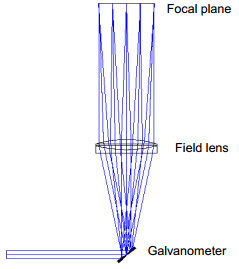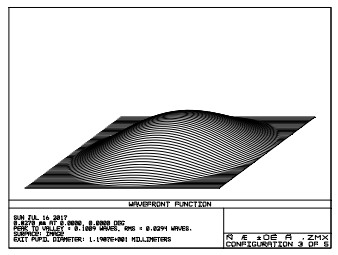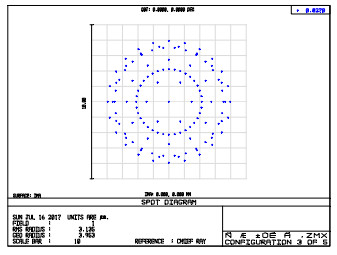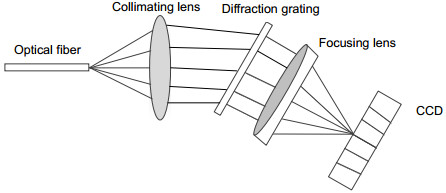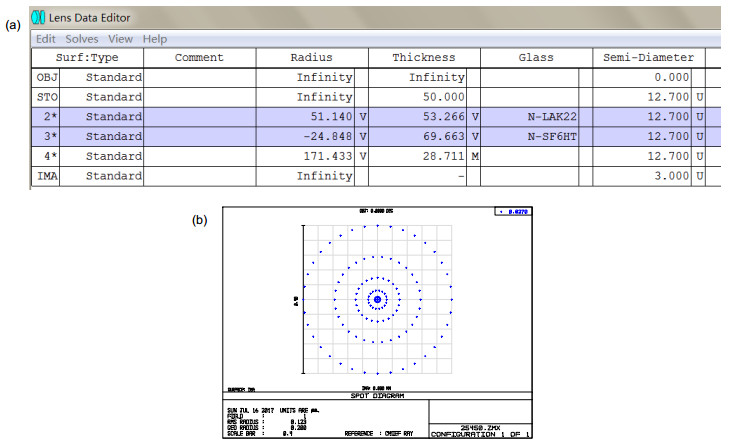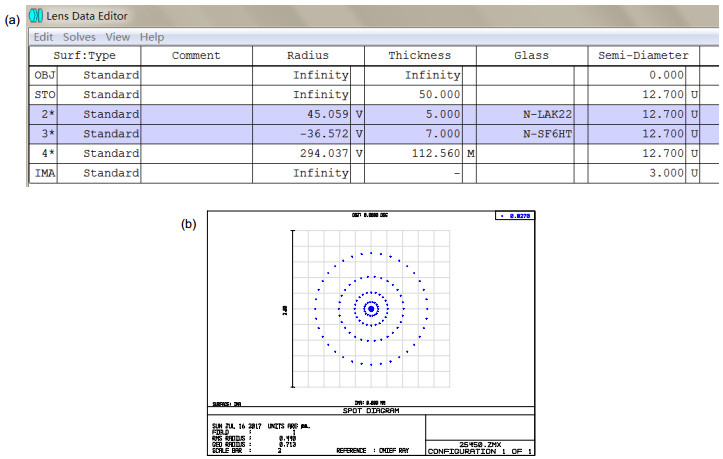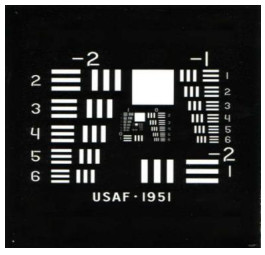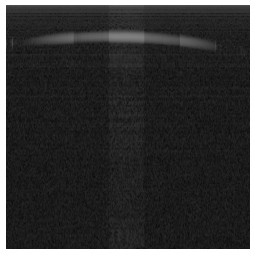-
摘要
对谱域光学相干层析(SD-OCT)系统中的透镜组进行设计优化,是提高系统成像质量的重要步骤。本文基于Zemax仿真对样品臂中的场镜和光谱仪中的聚焦透镜进行了设计和优化,并且根据点列图、波前图等分析手段对结果进行了像质评价。结果表明,本文设计的场镜可以使系统具有理想的成像质量和良好的横向分辨率;所设计的光谱仪中的聚焦透镜使得聚焦光斑的尺寸小于CCD的像素点宽度,避免了CCD在接收信号时各像元之间造成干扰,从而提高了光谱仪的分辨率。

Abstract
The design and optimization for lens group in spectral domain optical coherence tomography (SD-OCT) system is fairly important to improve the imaging quality. The field lens in sample arm and the focusing lens in spectrometer are designed based on Zemax, and the imaging quality is evaluated according to spot diagram and wavefront map. The results show that the field lens can provide ideal imaging quality and good lateral resolution. And the focusing lens in the spectrometer makes the size of focal spot smaller than the pixel width of CCD to avoid the interference in each pixel of CCD. In this way, we observe considerable improvement in the resolution of the spectrometer.
-
Key words:
- Zemax /
- SD-OCT /
- resolution /
- optimization
-
Overview

Spectral domain optical coherence tomography (SD-OCT) is a non-invasive cross-sectional imaging methodthat has been developed to obtain high-resolution tomographic images of biological, organic and inorganic objects. Thehigh resolution, imaging depth, acquisition speed, and sensitivity of the SD-OCT system are significant for medical imaging. However, there are many negative factors which will result in lower system resolution. For example, if the fieldlens in sample arm is not appropriate, the lateral resolution will decrease. Similarly, if the focusing lens in spectrometercannot provide the focal spot with a smaller size comparing with the pixel width of CCD, it will bring interference ineach pixel of CCD, and the resolution of the spectrometer will decrease. As a result, the design and optimization for lensgroup in SD-OCT system are fairly important to the resolution and imaging quality. The aim of this study is to providehigher resolution of the system by designing and optimizing the lens group in sample arm and spectrometer based onZemax, which can provide the optical designer with spot diagram, geometric aberration, optical transfer function andother means of analysis used to assess the imaging quality. The field lens in sample arm and the focusing lens in spectrometer are designed, and the imaging quality is evaluated according to spot diagram and wavefront map. The resultsindicate that the field lens can bring ideal lateral resolution of 7.9 μm, which is sufficient for high-resolution imaging.And the focusing lens in the spectrometer makes the size of focal spot smaller than the pixel width of CCD to avoid theinterference in each pixel of CCD. In this way, we observe considerable improvement in the resolution of the spectrometer, and the signal-to-noise ratio of the system is improved, too. After design and optimization with Zemax, we measuredthe lateral resolution of the system with the USAF1951 resolution board. The results show that the lateral resolution is 12μm, which differs from the simulation value by 5.1 microns. Then we calculate the resolution of the spectrometer withthe focusing lens we designed. It turns out that the resolution of the spectrometer determined by the pixel width of CCDis 0.0363 nm. In conclusion, the simulation results, experimental results and calculation results show that the lens groupwe designed can achieve good resolution and imaging quality, and provide a strong theoretical basis for the processing ofthe device.
-

-
-
参考文献
[1] Huang D, Swanson E A, Lin C P, et al. Optical coherence tomography[J]. Science, 1991, 254(5035): 1178–1181. doi: 10.1126/science.1957169
[2] Clivaz X, Marquis-Weible F, Salathé R P, et al. High-resolution reflectometry in biological tissues[J].Optics Letters, 1992, 17(1): 4–6. doi: 10.1364/OL.17.000004
[3] Puliafito C A, Lin C P, Huang D, et al. High-speed optical coherence domain reflectometry[J]. Optics Letters, 1992, 17(2):151–153. doi: 10.1364/OL.17.000151
[4] H Hue C, Le Cadre J P, Perez P. Tracking multiple objects with particle filtering[J]. IEEE Transactions on Aerospace and Electronic Systems, 2006, 38(3): 791–812. https://hal.inria.fr/file/index/docid/72605/filename/RR-4033.pdf
[5] Wang J H, Wang M R. System and method for improving image quality in vivo OCT imaging: US2012/065991[P]. 2013-06-06.
[6] Peng X, Yang S Z, Yu B, et al. Continuous imaging of the blood vessels in tumor mouse dorsal skin window chamber model by using SD-OCT[J]. Proceedings of SPIE, 2016, 9697: 96973N. doi: 10.1117/12.2213134
[7] Jiang H, Abukhalil F, Shen M, et al. Slit-lamp-adapted ultra-high resolution OCT for imaging the posterior segment of the eye[J]. Ophthalmic Surgery, Lasers and Imaging Retina, 2016, 43(1): 76–81. https://miami.pure.elsevier.com/en/publications/slit-lamp-adapted-ultra-high-resolution-oct-for-imaging-the-poste
[8] 周新. 光学相干层析成像横向扫描系统及外触发模式研究[D]. 浙江大学, 2007.
[9] 王毅. 谱域OCT多通道光栅光谱仪研究[D]. 中国计量学院, 2016.
[10] 曹跃祖, 田益民, 李福芸.圆孔衍射与瑞利判据的可视化研究[J].北京印刷学院学报, 2015(6): 61–64. http://www.cqvip.com/QK/85729X/201506/667613197.html
-
访问统计


 E-mail Alert
E-mail Alert RSS
RSS
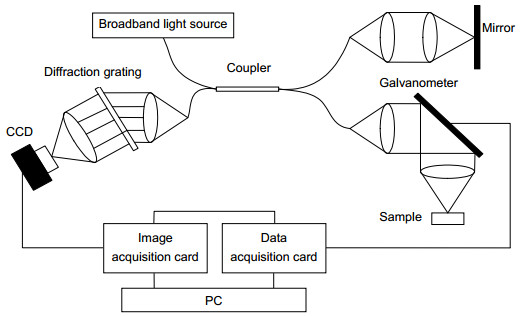
 下载:
下载:
